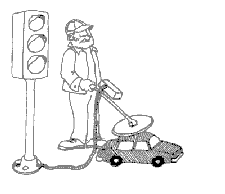Traffic signals can be a boon or boondoggle to the bicyclist. They are
a boon as they provide a controlled protected intersection for the predictable
bicyclist to negotiate. They are a boondoggle when the bicyclist arrives at a
red signal which does not appear willing to turn green.
What is a traffic detector?
Many traffic signals are controlled by a piece of wire, called a detector,
buried in the street. This detector, similar to a metal detector, will determine
the presence of metal objects. It will turn the light green when it detects a
sufficient amount of metal disrupting the coils' frequency. Automobiles are large
and create a large signal for the detector, therefore the light turns green readily
for them. Obviously a bicycle does not have as large a presence.
Can a bicycle trigger a traffic detector?
Absolutely! Traffic detectors have several designs. Unless a road has been repaved
since the detector was installed, you will be able to see the shape as you approach
the intersection. The placement of your bicycle is critical to being able to
successfully trigger the detector. If the cuts form a rectangle or square, stop
directly over one that is parallel to your direction of travel. If the rectangle has
an additional cut through the center, stop over the center line. If the cuts form a
diagonal pattern, stop right over its center. Some detectors have overlap- ping wires
in the corners of the rectangle. Stop there.
Bicycle placement is critical
Think for a moment about your bike. If the goal is to provide the largest area
of metal to trigger the detector, will your front wheel accomplish that goal?
Probably not.
 The amount of metal there is minimal. The frame, bottom bracket, cranks, and
pedal areas have a larger quantity of metal. Align it carefully over the visible
detector wires. You may be more successful placing that area of your bike over
the areas outlined above or those that may contain overlapping wires as in the
rectangle corners.
The amount of metal there is minimal. The frame, bottom bracket, cranks, and
pedal areas have a larger quantity of metal. Align it carefully over the visible
detector wires. You may be more successful placing that area of your bike over
the areas outlined above or those that may contain overlapping wires as in the
rectangle corners.
In some areas, motion detectors are now being used to "detect" traffic and trigger
signals. These devices may be mounted on the signal light or a pole next to the
intersection and work similar to the motion detectors installed with home and business
security systems and many automatic garage door openers. They project an invisible
beam designed to trigger when they detect the movement of a particular sized object.
Your challenge: ride through the invisible beam. A lazy "S" motion by the cyclist in
the potential area of the beam should be the most successful at tripping the trigger.
Uncooperative traffic detectors
Detectors of all types are, to varying degrees, effective devices for cyclists. They
require careful calibration to detect all possible road users effectively without
oversensitivity causing various malfunctions. Bicycles are vehicles. As the driver
of that vehicle, you, the cyclist, are responsible for obeying traffic laws. A
non-detecting signal prevents you from doing that. Report malfunctioning traffic
detectors to the appropriate local traffic official.
When all else fails
You are over the wire. You are patient. The light doesn't turn. Now what? Wait a
reasonable amount of time, even at a signal you know may not respond, then treat it
as a stop sign and proceed when the crossroad is clear. And, definitely report
that signal!
The graphic above is excerpted from Urban Biker,' Tricks & Tips" by Dove Glowacz,
due in June with over 700 illustrations.
Reprinted from "Bicycle USA", magazine of the League of American
Bicyclists, May/Jun 1997. Effective CyclingTM.
For more information about the League of American Bicyclists, visit
their web site, www.bikeleague.org,
or e-mail them at bikeleague@aol.com.